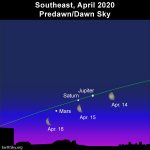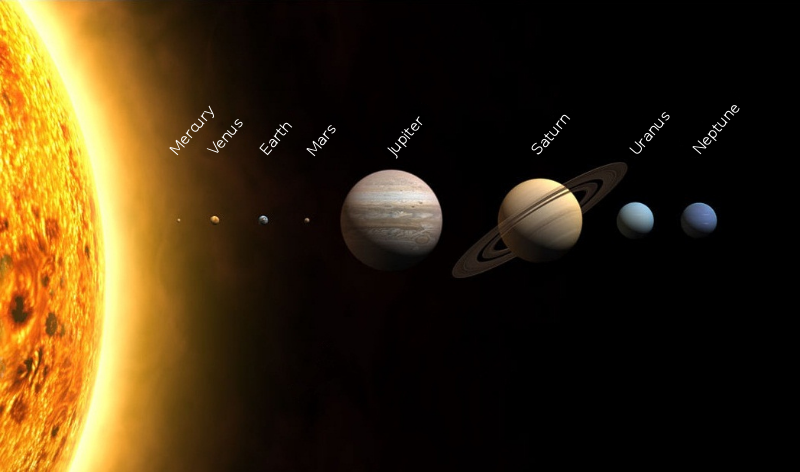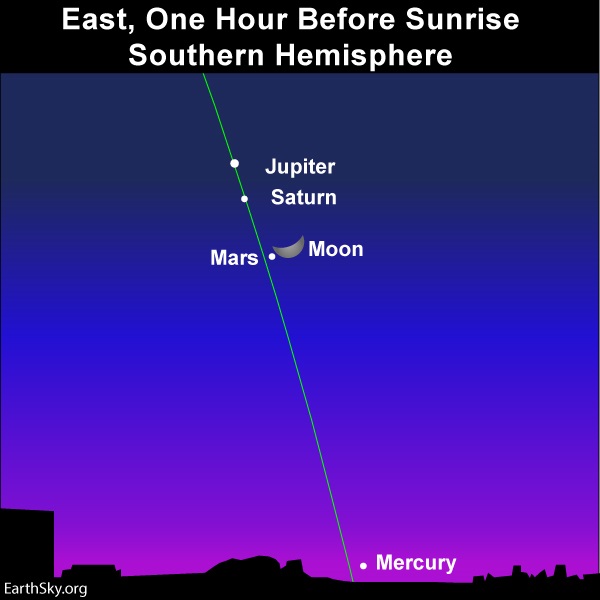
Before daybreak these next several mornings – April 14, 15 and 16, 2020 – watch for the moon to sweep by three morning planets: Mars, Saturn and Jupiter. You’ll be looking along the ecliptic, the same approximate path the sun and moon travel from east to west. Look southeast to south from the Northern Hemisphere. Look northeast to north from the Southern Hemisphere. For all of us around the globe, the moon is waning now, or appearing closer to the sunrise each morning.
And, for all of us, on the morning of April 14 the moon’s illuminated side will be pointing right at this compact line-up of planets. Then on the mornings of April 15 and 16, you’ll see the moon in the planets’ midst.
Jupiter is easily the most brilliant of the trio of planets, beaming some 14 times brighter than either Saturn or Mars. Even so, Mars and Saturn are respectably bright, shining as brightly as 1st-magnitude stars. So you’ll be looking for a little line of three bright objects, with one of them (Jupiter) very much brighter than the other two. As you gaze toward this trio, know that Saturn lies in between Mars and Jupiter.
Of course, these worlds shine by reflecting the light of the sun. At present, Mars and Saturn are about equally bright. But it’s fairly easy to distinguish these two worlds by color. Mars glowers red while Saturn exhibits a golden hue. If you have difficulty seeing color with the eye alone, try your luck with binoculars.

The relative sizes of the solar system planets via NASA. Distances are not to scale. Mercury and Venus are called inferior planets because they orbit the sun inside of Earth’s orbit.
Mercury, the innermost planet, is nominally a morning planet all though April 2020. However, as seen from the northern half of Earth now, Mercury will be buried deeply in the glow of morning twilight. At the equator, Mercury rises about one hour before the sun. At 35 degrees south latitude, Mercury rises about 1 1/2 hours before sunrise; you might see it from there.

The view of the moon and morning planets from the Southern Hemisphere (Cape Town, South Africa) before sunrise April 16, 2020.
So four of the five bright planets may be found in the April 2020 morning sky. The brightest planet of them all – Venus – is found in the west after sunset, and will remain a fixture of the evening sky for the next 1 1/2 months. Watch for Venus to shine at its brilliant best as the evening “star” in late April 2020.
Mercury and Venus are called inferior planets, because they orbit the sun inside of Earth’s orbit. Inferior planets exhibit the whole range of phases, much like our own moon does. You need a telescope to watch these changing phases, however. Right now presents a great time for watching Venus through a telescope because Venus is now displaying a waning crescent phase, which is much easier to discern than a gibbous phase.

As Venus comes closer to Earth in the evening sky, its phase shrinks but its disk size enlarges. The converse is also true. Whenever Venus gets farther away from Earth in the morning sky, its phase increase but its disk size diminishes. Image credit: Statis Kalyvis
On the other hand, a superior planet is a planet that orbits the sun outside of Earth’s orbit.
Bottom line: Get up before dawn these next several days – April 14, 15 and 16, 2020 – to see the moon and the bright bright superior planets in the morning sky: Mars, Saturn and Jupiter.
from EarthSky https://ift.tt/2wAlopT

Before daybreak these next several mornings – April 14, 15 and 16, 2020 – watch for the moon to sweep by three morning planets: Mars, Saturn and Jupiter. You’ll be looking along the ecliptic, the same approximate path the sun and moon travel from east to west. Look southeast to south from the Northern Hemisphere. Look northeast to north from the Southern Hemisphere. For all of us around the globe, the moon is waning now, or appearing closer to the sunrise each morning.
And, for all of us, on the morning of April 14 the moon’s illuminated side will be pointing right at this compact line-up of planets. Then on the mornings of April 15 and 16, you’ll see the moon in the planets’ midst.
Jupiter is easily the most brilliant of the trio of planets, beaming some 14 times brighter than either Saturn or Mars. Even so, Mars and Saturn are respectably bright, shining as brightly as 1st-magnitude stars. So you’ll be looking for a little line of three bright objects, with one of them (Jupiter) very much brighter than the other two. As you gaze toward this trio, know that Saturn lies in between Mars and Jupiter.
Of course, these worlds shine by reflecting the light of the sun. At present, Mars and Saturn are about equally bright. But it’s fairly easy to distinguish these two worlds by color. Mars glowers red while Saturn exhibits a golden hue. If you have difficulty seeing color with the eye alone, try your luck with binoculars.

The relative sizes of the solar system planets via NASA. Distances are not to scale. Mercury and Venus are called inferior planets because they orbit the sun inside of Earth’s orbit.
Mercury, the innermost planet, is nominally a morning planet all though April 2020. However, as seen from the northern half of Earth now, Mercury will be buried deeply in the glow of morning twilight. At the equator, Mercury rises about one hour before the sun. At 35 degrees south latitude, Mercury rises about 1 1/2 hours before sunrise; you might see it from there.

The view of the moon and morning planets from the Southern Hemisphere (Cape Town, South Africa) before sunrise April 16, 2020.
So four of the five bright planets may be found in the April 2020 morning sky. The brightest planet of them all – Venus – is found in the west after sunset, and will remain a fixture of the evening sky for the next 1 1/2 months. Watch for Venus to shine at its brilliant best as the evening “star” in late April 2020.
Mercury and Venus are called inferior planets, because they orbit the sun inside of Earth’s orbit. Inferior planets exhibit the whole range of phases, much like our own moon does. You need a telescope to watch these changing phases, however. Right now presents a great time for watching Venus through a telescope because Venus is now displaying a waning crescent phase, which is much easier to discern than a gibbous phase.

As Venus comes closer to Earth in the evening sky, its phase shrinks but its disk size enlarges. The converse is also true. Whenever Venus gets farther away from Earth in the morning sky, its phase increase but its disk size diminishes. Image credit: Statis Kalyvis
On the other hand, a superior planet is a planet that orbits the sun outside of Earth’s orbit.
Bottom line: Get up before dawn these next several days – April 14, 15 and 16, 2020 – to see the moon and the bright bright superior planets in the morning sky: Mars, Saturn and Jupiter.
from EarthSky https://ift.tt/2wAlopT

Aucun commentaire:
Enregistrer un commentaire